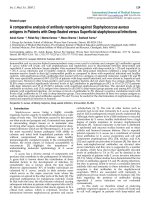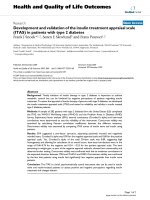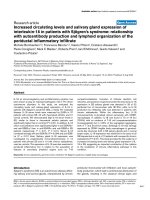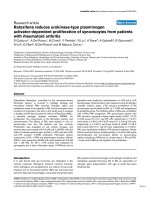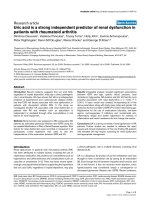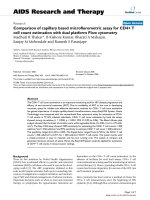Báo cáo y học: " Functional markers to predict the need for prolonged mechanical ventilation in patients with Guillain-Barré syndrome" ppsx
Bạn đang xem bản rút gọn của tài liệu. Xem và tải ngay bản đầy đủ của tài liệu tại đây (110.61 KB, 2 trang )
We read with great interest the article by Fourrier and
colleagues [1], who investigated functional markers to
predict the need for prolonged mechanical ventilation
(MV) in patients with Guillain-Barré syndrome (GBS)
and acute respiratory failure. e study was well con-
ducted, but we are concerned about the study design and
the confounding factors.
Firstly, we want to know why the authors chose 15 days
as a cutoff point of MV duration. As mentioned in the
article, tracheotomy is indicated in GBS patients when a
long duration of MV is expected [1]. Although the
optimal time for performing tracheotomy is not well
known, it is usually considered after 3 weeks of prolonged
MV [2]. In this context, we are eager to know whether the
lack of foot fl exion ability was associated with a MV
length of more than 21 days. If so, it might be used as a
predictor for tracheotomy. Secondly, the authors seem to
equate MV with endotracheal MV in their research. We
therefore want to ask whether the authors used non-
invasive mask MV in patients at the very early stages of
respiratory failure. irdly, delay between disease onset
and admission or initiation of immunotherapy seems to
diff er among GBS patients. is may confound the data
analysis since the predictive values of foot fl exion ability
may diff er between patients beginning to receive immuno-
therapy from the recovery stage and from the acute stage
[3]. Lastly, although immunotherapy can change the
natural course of GBS, other factors may act in an
opposite way. Complicated infections and electrolyte
disorders [4] may aggravate respiratory muscle weakness
and lead to prolonged use of MV.
© 2010 BioMed Central Ltd
Functional markers to predict the need for
prolonged mechanical ventilation in patients with
Guillain-Barré syndrome
Hongliang Zhang*, Tao Jin and Jiang Wu
See related research by Fourrier et al., />LETTER
Author’s response
François Fourrier and Laurent Robriquet
We thank Dr Zhang and colleagues for their comments
on our article.
In our study, we mainly considered the 15 days cutoff
point on a ‘pragmatic’ basis. In GBS patients, immuno-
therapy needs to be given for 5 to 7 days and the fi rst
signs of improvement are expected in the following 7days.
If at the end of immunotherapy a marker may predict a
lack of improvement, waiting more time will delay
tracheo tomy needlessly and may result in a higher risk of
complications. In agreement, presently published recom-
mendations and experts’ opinions mostly consider 10 to
15 days as the optimal delay for performing tracheotomy
[5,6]. Moreover, tracheotomy after 21 days might be
associated with longer ICU stay and higher mortality [7].
Non-invasive mechanical ventilation (NIMV) was not
used in our severe GBS patients. ey are usually
considered poor candidates for NIMV, being at very high
risk of sudden respiratory arrest, aspiration, atelectasis,
and cardiac troubles. Due to facial paresis, severe air
leaks may limit effi cacy and tolerance. Prolonged NIMV
may provoke severe skin lesions and induce high care
loads and monitoring needs [8].
None of our patients was treated from the recovery
phase. e median delay between onset of the disease
and ICU admission was 6 days, and all patients were
given immunotherapy in the ICU soon after admission.
Finally, we completely agree that infection and electro-
lyte disorders should be aggressively treated. is is
surely of great matter and refers to standard critical care.
e best way to improve neurological status remains to
shorten the course of the disease by early immunotherapy.
*Correspondence:
Department of Neurology, the First Hospital of Jilin University, Jilin University,
Xinmin Street 71#, 130021, Changchun, China
Zhang et al. Critical Care 2011, 15:426
/>© 2011 BioMed Central Ltd
Abbreviations
GBS, Guillain-Barré syndrome; MV, mechanical ventilation; NIMV, non-invasive
mechanical ventilation.
Competing interests
The authors declare that they have no competing interests.
Published: 20 May 2011
References
1. Fourrier F, Robriquet L, Hurtevent JF, Spagnolo S: A simple functional marker
to predict the need for prolonged mechanical ventilation in patients with
Guillain-Barré syndrome. Crit Care 2011, 15:R65.
2. Plummer AL, Gracey DR: Consensus conference on arti cial airways in
patients receiving mechanical ventilation. Chest 1989, 96:178-180.
3. Sharshar T, Chevret S, Bourdain F, Raphaël JC; French Cooperative Group on
Plasma Exchange in Guillain-Barré Syndrome: Early predictors of mechanical
ventilation in Guillain-Barré syndrome. Crit Care Med 2003, 31:278-283.
4. Ambrosino N, Gabbrielli L: The di cult-to-wean patient. Expert Rev Respir
Med 2010, 4:685-692.
5. Durbin CG: Tracheotomy: why, when, and how? Respir Care 2010,
55:1056-1068.
6. Trouillet JL, Combes A, Luyt CE, Nieszkowska A, Chastre J: Early tracheotomy:
the end of the controversy. Reanimation 2011, 20:25-30.
7. Hsu CL, Chen KY, Chang CH, Jerng JS, Yu CJ, Yang PC: Timing of
tracheostomy as a determinant of weaning success in critically ill patients:
a retrospective study. Crit Care 2005, 9:R46-52.
8. Garpestad E, Brennan J, Hill NS: Noninvasive ventilation for critical care.
Chest 2007, 132:711-720.
doi:10.1186/cc10144
Cite this article as: Zhang H, et al.: Functional markers to predict the need
for prolonged mechanical ventilation in patients with Guillain-Barré
syndrome. Critical Care 2011, 15:426.
Zhang et al. Critical Care 2011, 15:426
/>Page 2 of 2
